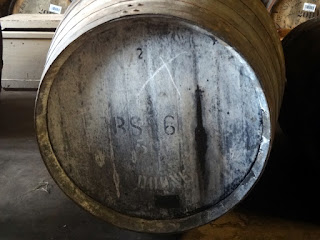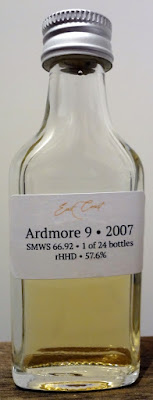Thanks to the samples provided at the distillery, I try those again a couple of days later, outside of the warehouse configuration, with a higher ambient temperature and no rush, so as to make a more reliable opinion.



I am an old man. I am from Huy. I drink whisky. (And I like bad puns.)
Thanks to the samples provided at the distillery, I try those again a couple of days later, outside of the warehouse configuration, with a higher ambient temperature and no rush, so as to make a more reliable opinion.



Despite the pandemic, Deanston is conducting some tours (with added precautions, it goes without saying). No chance drop-in; it has to be booked in advance. JS reckoned this Warehouse No. 4 tasting was the most interesting, so here we are, for today's last session.
 |
| Added COVID-19 precautions |
Only three of us attend. We are led to the warehouse in question, which is a strange mix of concrete floor and low ceiling, casks stacked three high and low-ish temperature. It is neither a racking warehouse, nor a real dunnage warehouse -- much less a palletised one.
Three casks are waiting for us on the floor, and three bottles, drawn from each of the casks, are on a cask top: because of COVID-19, there will be no live valinching, unfortunately.



Unfortunately, I have spent all my disposable on the way here, or I would buy the ex-Fino. JS prefers the ex-Bourbon, of course.
It is a nice touch on the part of the distillery to provide empty sample bottles for the driver. Also, the pours are very generous. On the other hand, the session is pretty short: forty-five minutes to try three generous doses of cask-strength whisky feels a bit rushed to me. It also feels as if the guide is on a strict schedule, and keen to not deviate from it. Considering the pandemic-related restrictions, I cannot blame him for it; it simply is less enjoyable for that.
Fortunately, we have three full samples to try again later. Not a bad thing at all, considering the temperature in the warehouse mutes most of the flavours.
When the tasting finishes, we are left with only fifteen awkward minutes to shop. Worst of all, though: the cafeteria is closed. There goes our plan to eat there. Again, perhaps a consequence of the pandemic, but a pity nonetheless.
 |
| For the film buffs, this cask is signed by the cast of The Angels' Share |
 |
| The iconic main building of the distillery |




Third and final act of this Whisky-Online Auctions triptych dedicated to First Cask. Tim Roberts, Wayne and Harrison Ormerod chair from aback, whilst Lee 'Connas' Connor presents.
As the previous times, I try these superficially, keeping enough to spend more time with each dram at a later date.

 |
| Connas found a newspaper clip about a court case that involves St Magdalene whisky being stolen |

Connas: "It's quite wood-forward on the nose."


Connas talks about maturation. He has a couple of good slides about the solera system that is so widely used in Spain's bodegas.

Connas introduces the next dram as, "the Beast of Speyside, meaty and sometimes willingly sulphur-y."


Short notes. It is late. I will come back to it later. It is a killer dram, without a doubt. It might not be C#2738 (few things are), but it is obviously from the same bloodline and I love it.
The Linlithgow is the overwhelming winner of tonight's popularity contest; it certainly is mine. One person preferred the Macallan, one liked the Highland Park best, a couple of votes go to the Mortlach, another couple to the Glen Grant, and, much to my surprise, not a single vote goes to the Ardbeg.
Quality night, with more interaction and better banter than on the second tasting. If my scores are to be believed, this line-up one had the weakest drams, despite having the most impressive list of names, but it was just as interesting as the other two evenings, really. That comforts me in my opinion that there is not a dud in that collection.



You may recall that, over a year and a half ago, tOMoH and friends attended an SMWS event during which the SMWS founder, Phillip 'Pip' Hills, talked about the early days of the SMWS and other adventures of his. You may also recall that the event left a bitter taste, for the value for money was lower than it was north of the border, and the drams offered were seemingly random drams available from the bar at the time. Finally, you will remember Hills was promoting his new book, which we all received a copy of on the night.
Well, tOMoH finished reading the book. No, it did not take him a year and a half. It took him a year and a half to start it, then a few days to devour it.
Let us get this out of the way: Pip Hills's The Founder's Tale: A Good Idea and a Glass of Malt, Birlinn, 2019, is not a book about whisky. As The Way of Whisky, it is a book about life, which happens to mention whisky with some frequency. Indeed, it is an autobiography, or, more accurately, selected excerpts from the life of Pip Hills. And what a life!
Here is the entertaining tale of a man who turns out to be a resourceful adventurer; he seems to have travelled everywhere on the planet, can build or repair anything with only minimal or makeshift tooling and has done both those things within the financial constraints that apply to any regular person. If this book were made into a television series, it would probably rival MacGyver.
What is more, it is not just the content that is good: Hills is a talented storyteller, and an excellent writer. His style captivated me, as the stories filled me with disbelief, made me laugh wholeheartedly, and shed a tear in the space of three pages.
Nevertheless, the man is very lucid regarding his luck. He acknowledges that the circumstances were very different in the early-1980s and that he foresaw a market that, at the time, virtually did not exist in the UK. There are some advantages to being a trailblazer, and this tale illustrates that perfectly.
This work is also a humbling life lesson, as one inevitably compares the author's life to their own. Few are those who can look back and say they have achieved as much as Pip Hills. Fewer still do so with the modesty that common decency requires.
Humble pie has been eaten, and that hasty judgement has had to be revised. Based on the book, it is apparent that Pip Hills is not exactly rich and never was; he is simply in that category of people whose relation to money encourages them to spend it as it comes in. He does/did count some affluent people amongst the seemingly infinite pool of friends he maintains, but not all of them are/were.
I sincerely hope the book is made into a cartoon one day -- each chapter an episode. There are a lot of inspiring lessons in there for all to learn, and treated with such humour and candour that the whole is accessible to all.
If the above was not clear, tOMoH recommends the book.
What else but an ancient SMWS bottling to punctuate that?
